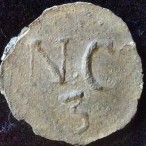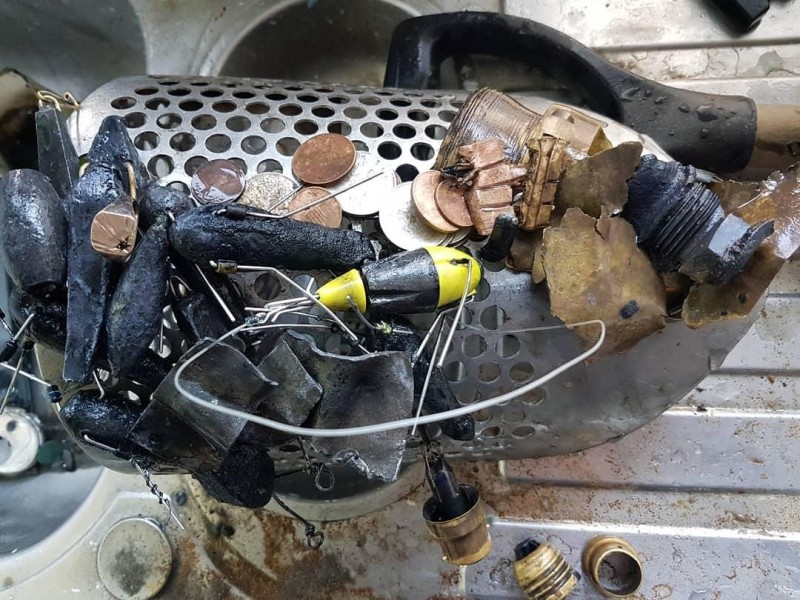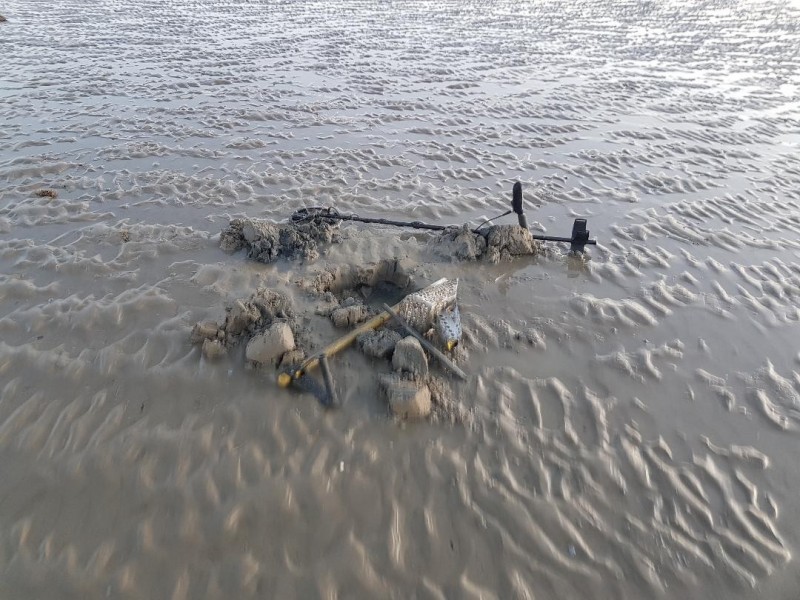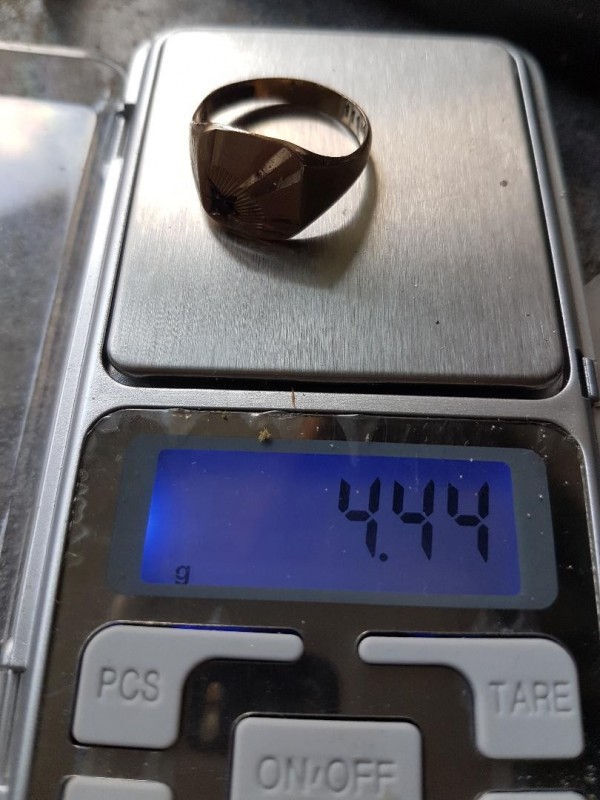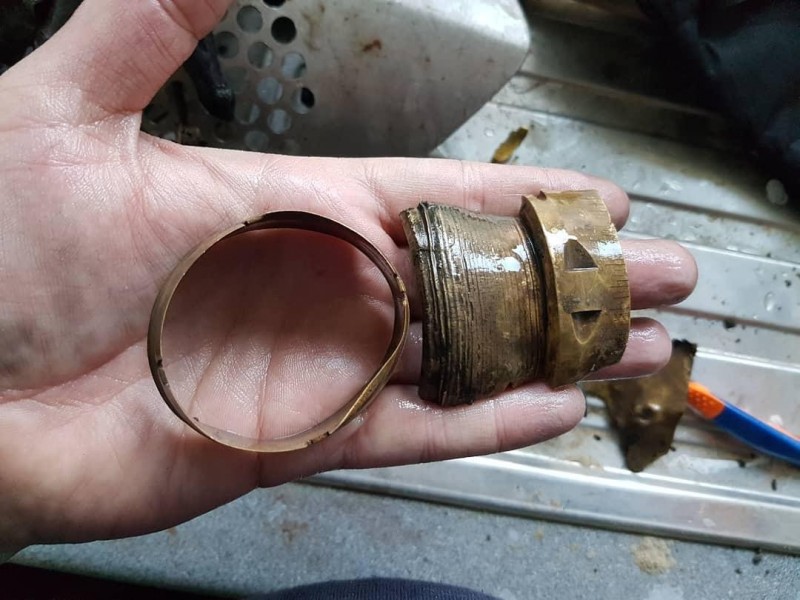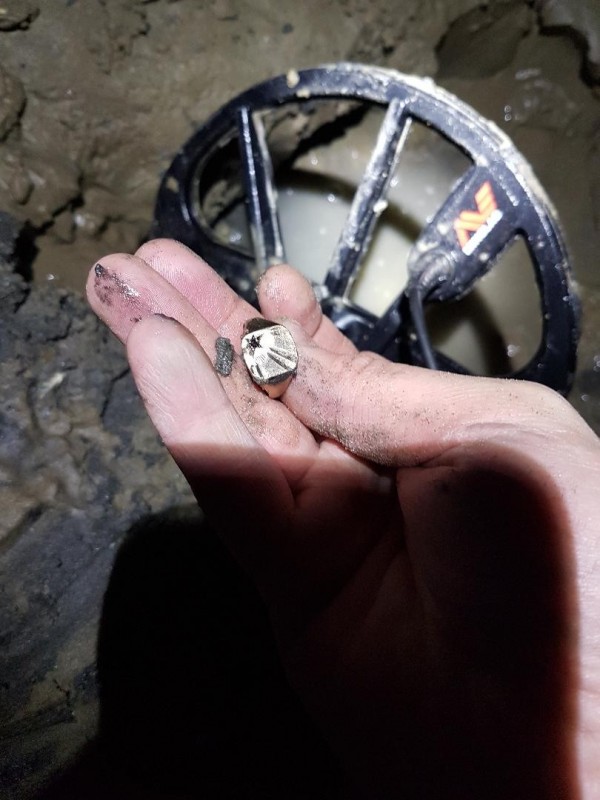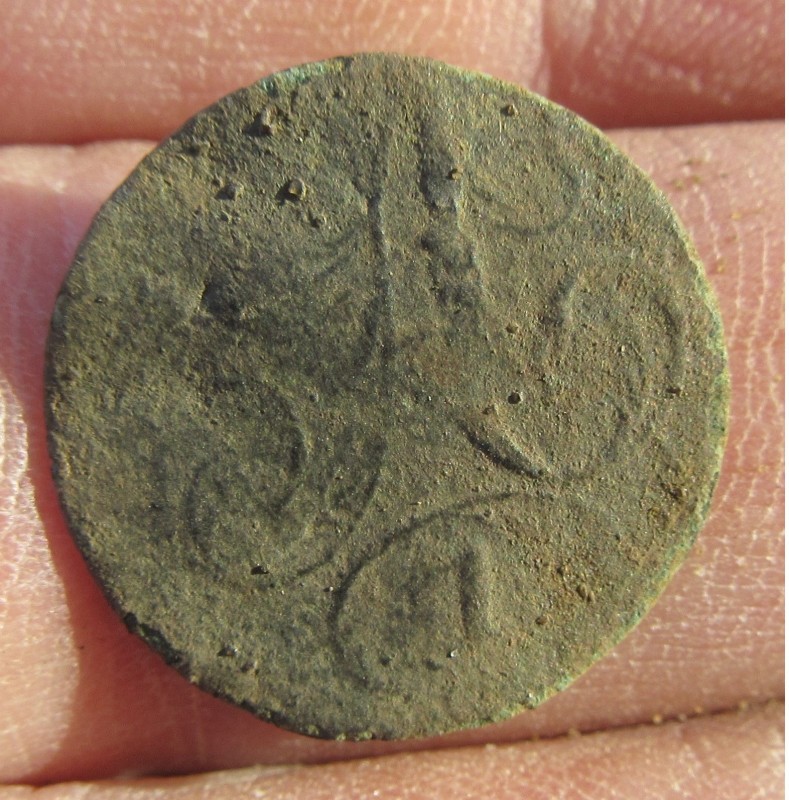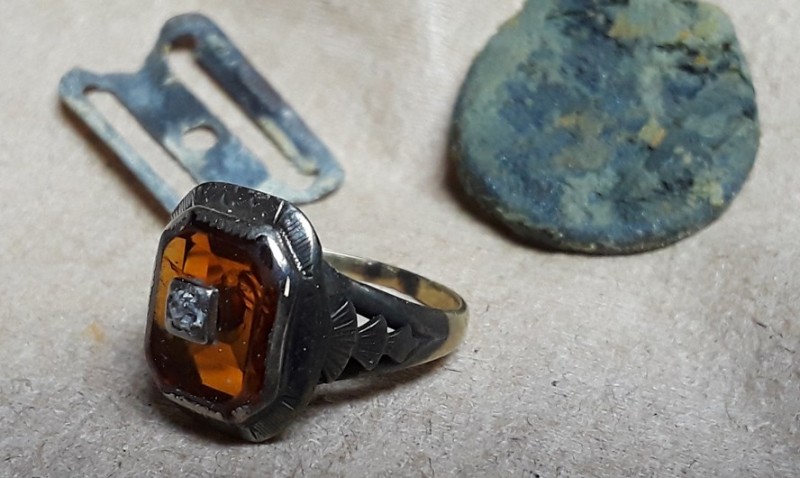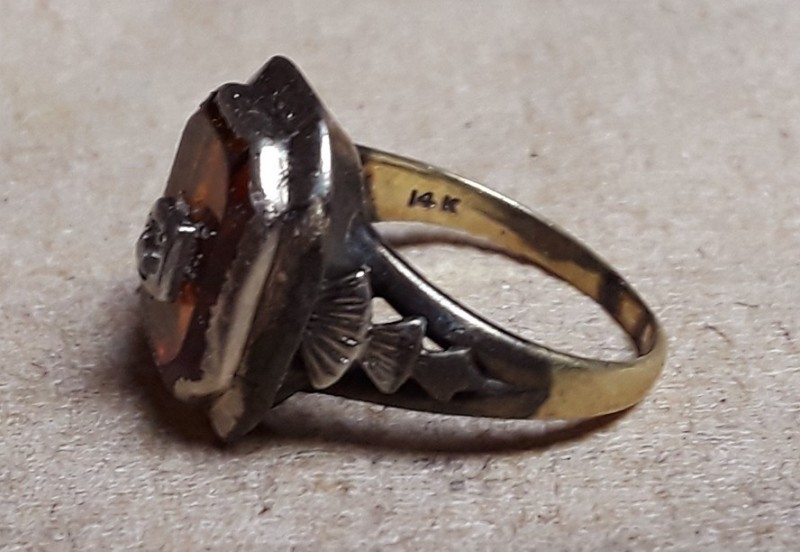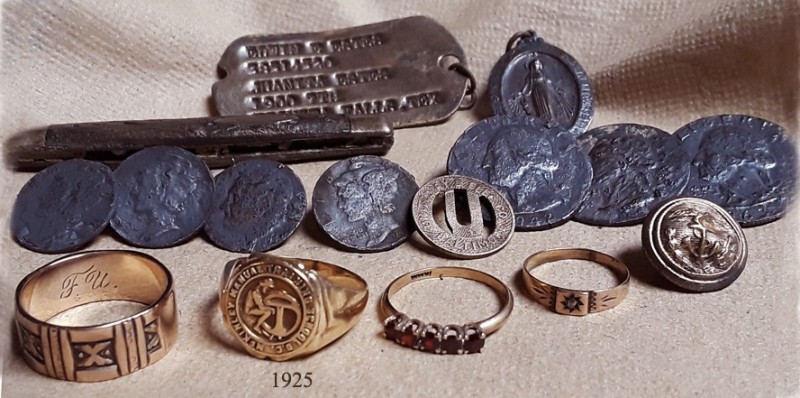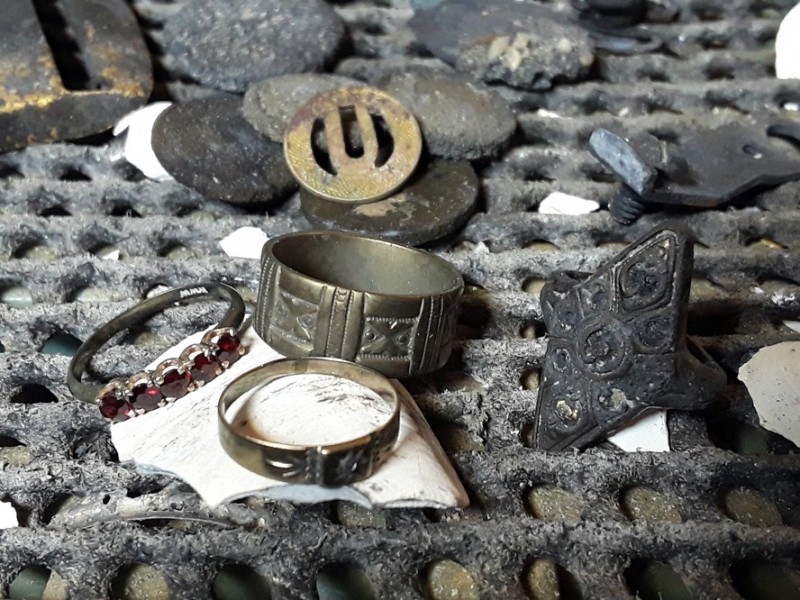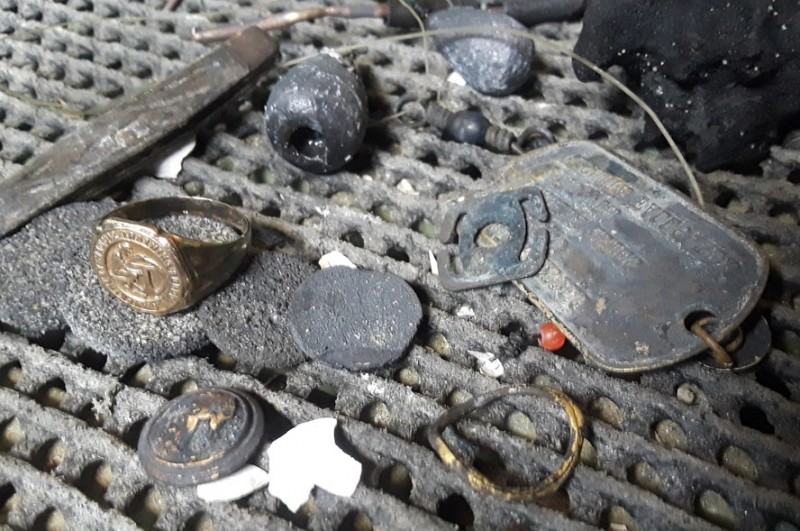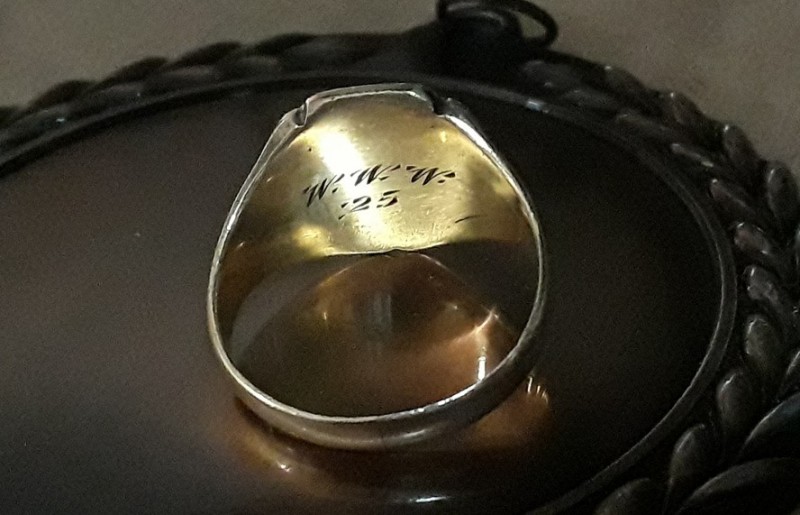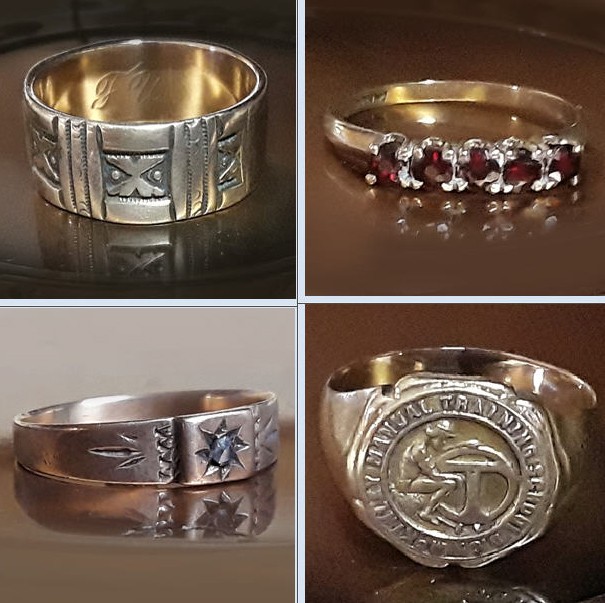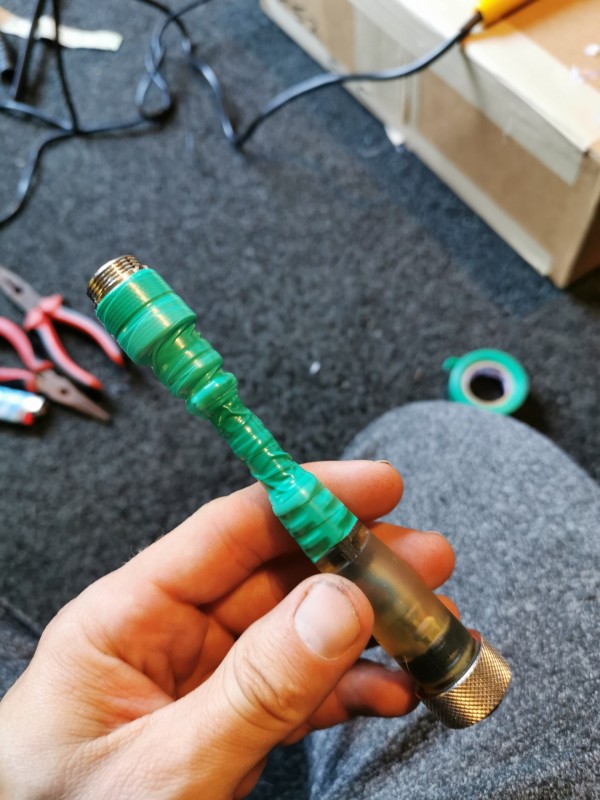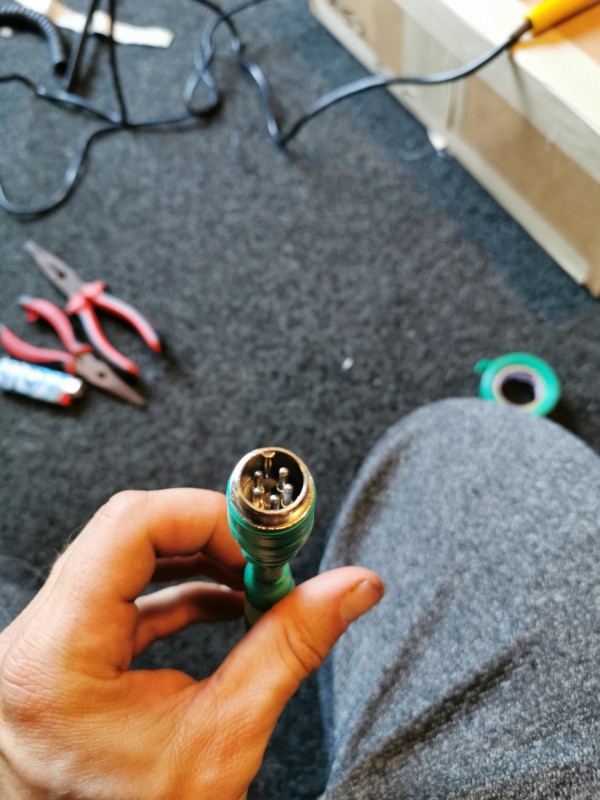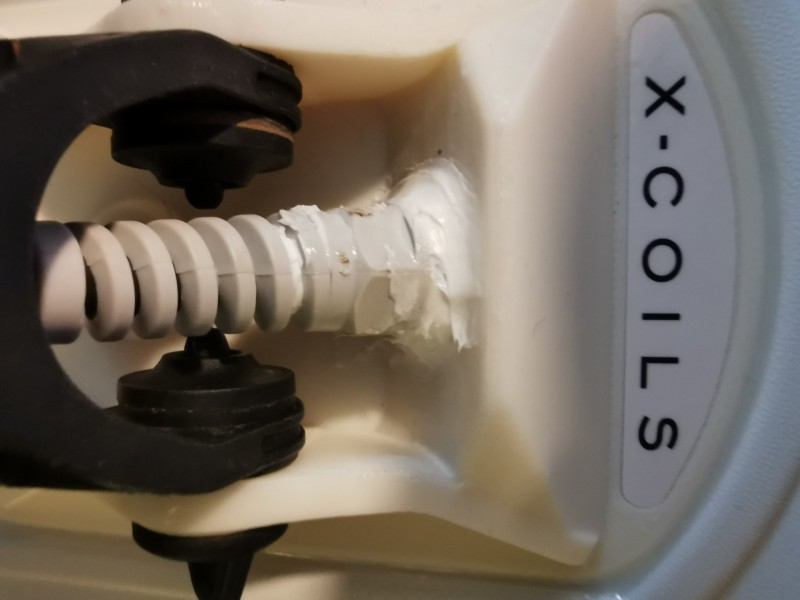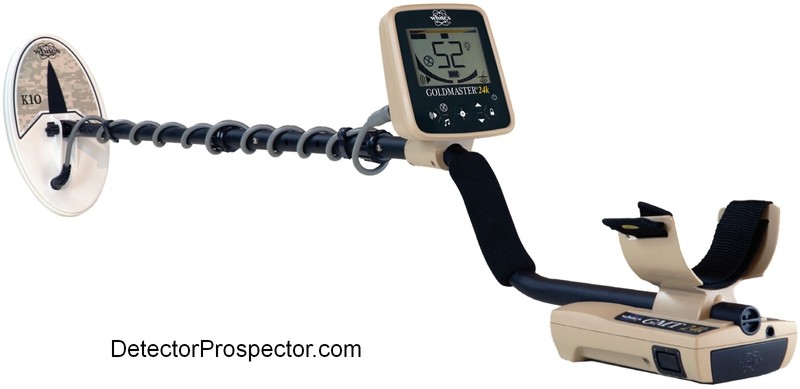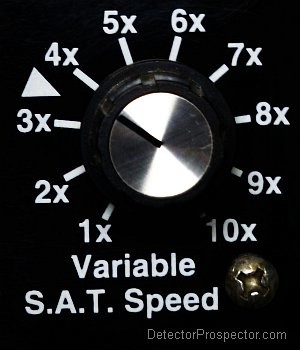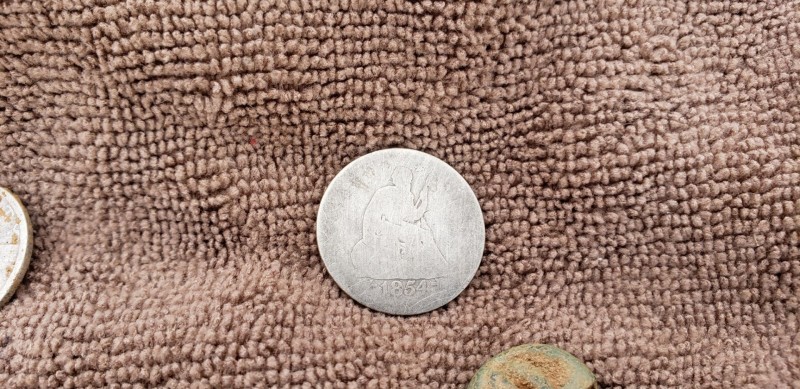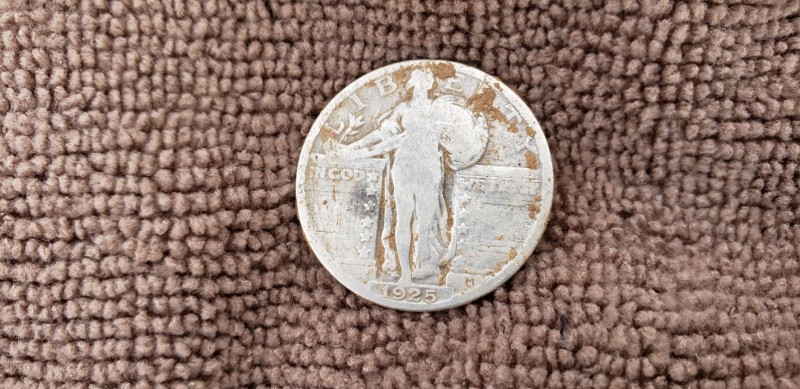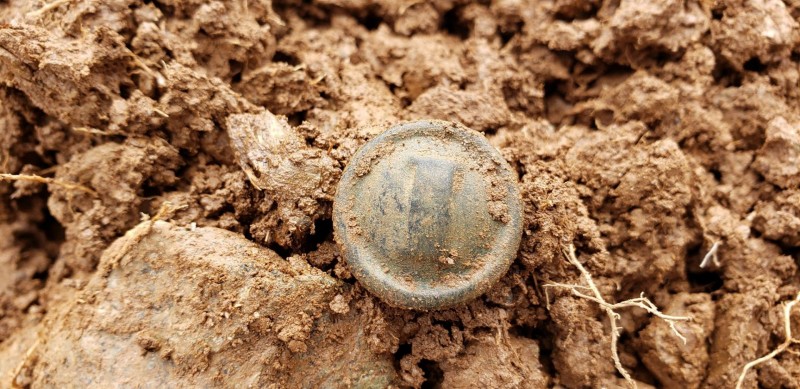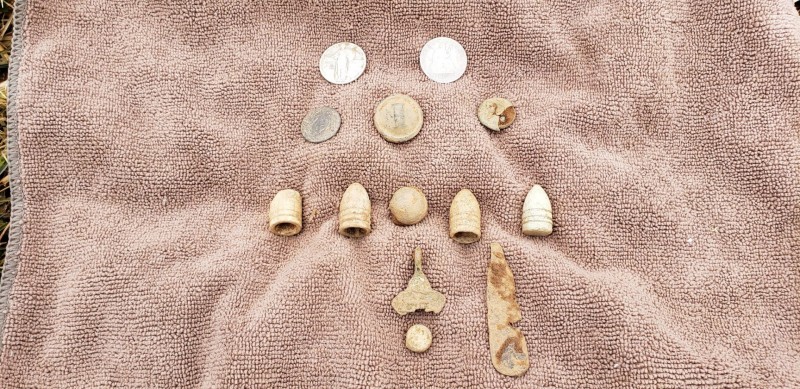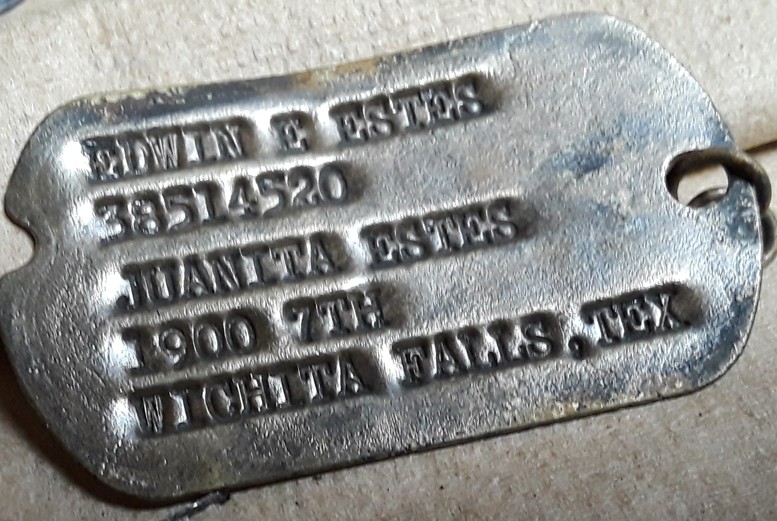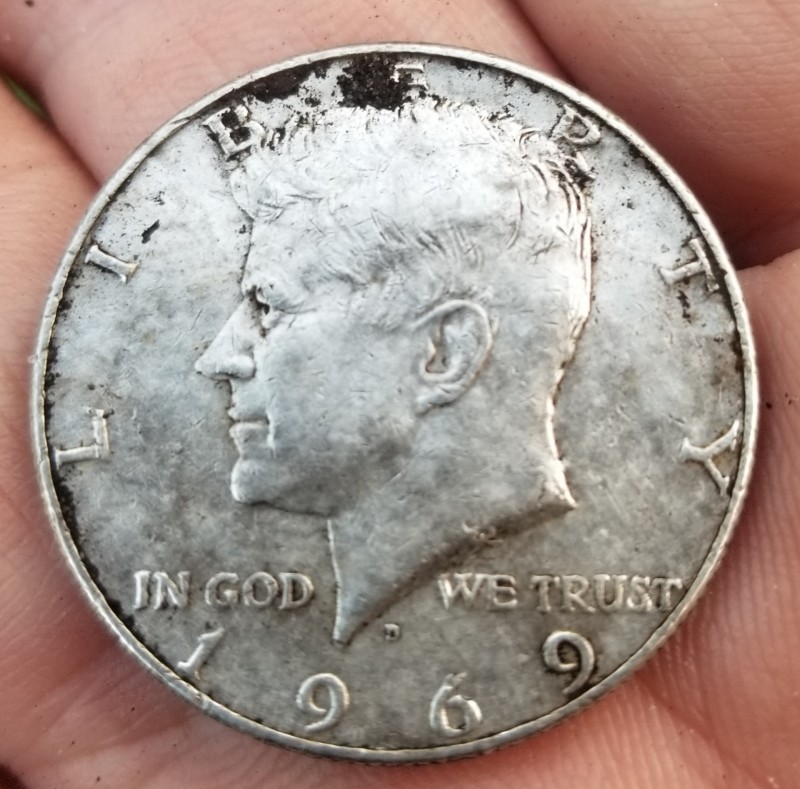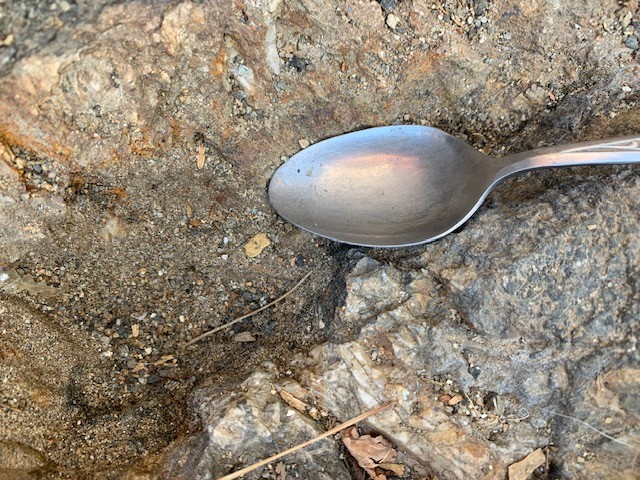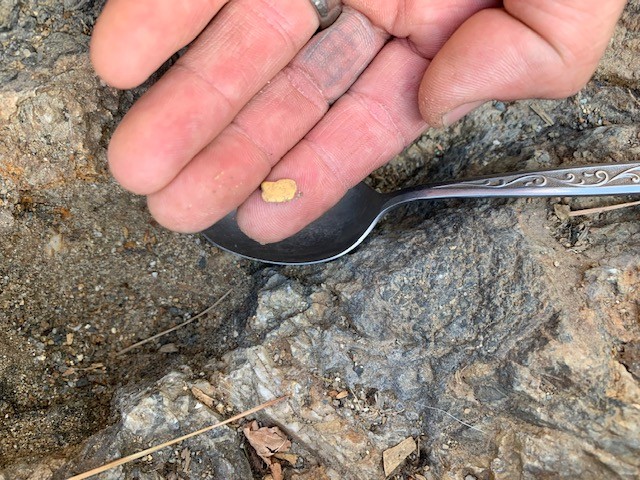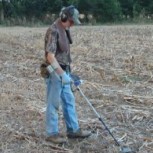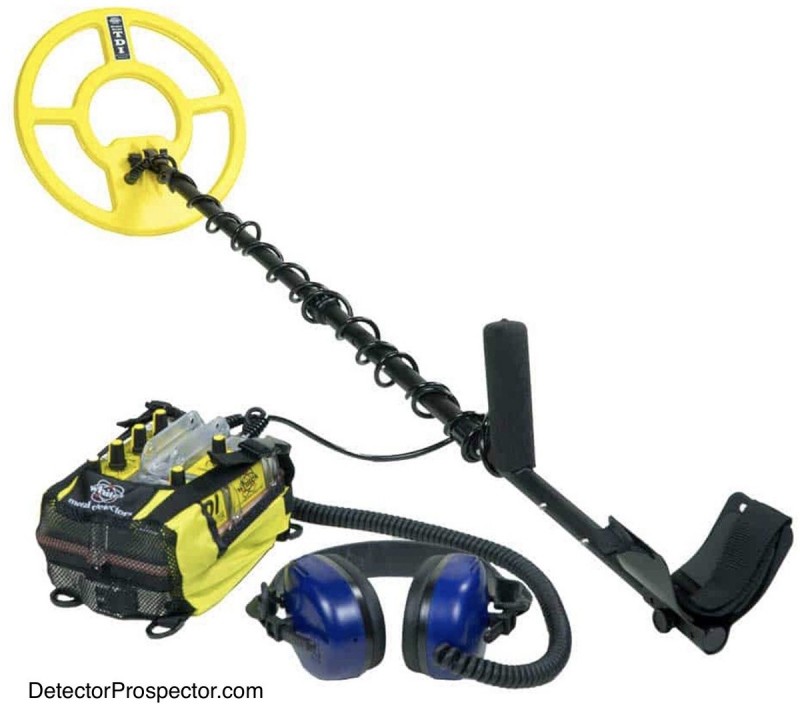Leaderboard
Popular Content
Showing content with the highest reputation on 02/12/2020 in all areas
-
7 points
-
Hello to all was was away in Vietnam for 3 weeks weeks eating and discovering the country but the crave for beach combing pushed me to schedule all my shifts straight at work then head to the coast. A Strom is battering the UK at the moment but i wasn't really interested in that i had my eyes on a beach which i think has been ignore for a while......not a really good access as the road isn't maintained and i dont have a 4x4 so i need to be careful if i dont want to leave most of my car there😅 So i took my nox which i swap for my CTX in January and headed to the spot at 5 am. Signals started straight away with big lump of brass, then i started to pick up fishing weight one after another then i hit Gold with this nice 9ct 4.45gr alas 9ct.....😪 Then few holes later my DIY unbreakable shaft broke but i brought a super dupa spade so i headed to the car and after a water refill(Was sweating despite the strong winds and low temp) i carried for another 2 hours finding the biggest anti aircraft shrapnells i ever found ,imagine been hit by that.The fishing weight are apparently 70/80s.....and the deus shaft you see on the picture of the broken shaft was actually the one i put inside to reinforce Anyway please find the result in picture,i think that that beach has much to offer will try to do another or two long session with the Nox then i will hit it with the PI.....if i succeed it will means 1 thing...my tenacity has paid off or maybe i am just getting to know the beaches better.............. Enjoy RR7 points
-
Over the weekend digs. First day(Saturday) I hit a 1890s homesite, it dates 1890s to 1930s, then next day(Sunday) went and hit one of my colonial site that I been hitting for a while.Script A, war of 1812 button, V-nickel, Sunday school pin, few flat buttons and other goodies. Script A, war of 1812 button 1908 V-nickel. Sunday School pin Few flat buttons Spoon handle Everything. Old trigger guard with some rusty iron.7 points
-
5 points
-
3 points
-
Yes, I want to see more patches come back to life as they have for JW! I've just had my initial day with it so far and there are many more to come. I've got a couple of days lined up with friends so I thought I'd make the same offer to forum friends. All days out in the field are enjoyable and finding some yellow pieces makes it more so sometimes. Mitchel3 points
-
I already have in my mind all mods to transform it in a good dive machine. Believe me, the biggest question right now for me, still remain how to use seriously a 7Ms delay in saltwater. I'm able to remove small copper plated iron cents on my TDIbh misadjusting the GB and to leave gold safe under big coins that I don't dig. (Thanks Steve!). The threshold drift at 10Ms is sometimes a pain however, even with sensitivity on 70% and in really shallow water. Hopefully a stable threshold will be the key for this machine. I know the ferrous/non ferrous target separation is at it's best due to the videos. Now I only need to test one of the first that will be here in Europe to sleep in peace😁3 points
-
As much as I love the Gold Monster, the 24K audio in both all metal VCO and discrimination two tone modes, the XGB ground balance options, the iron cancel options, the threshold tone options (a really big one for me!) and the "to die for" digital backlit display along with that super hot 6.5" coil make it a better choice for me.3 points
-
Craig, right now White's is using all of their 6 by 4s in the promotion for the GMX. The demand for the GMX has been greater than expected, thus 6 x 4's are in short supply. It might be a couple of weeks before they are available publicly. I have one of the first ones and absolutely love it! Just be patient bro. HH Jim2 points
-
I'll cautiously throw in on this since I live in S. CA and have been hunting the beaches out here since the early 1980's. I have used the TDI Beach Hunter and the Equinox 800 extensively. Cautiously since I want to preface this by saying that this is only my experience. The last time I posted a comment about this same subject, on a simple YouTube video, I got torched by PI loyalists. So here goes. From my own experience and observations, the Equinox is every bit the match for the TDI Beach Hunter. Its depth is amazing, as is its sensitivity to small gold. Let me share one experience with you that will prove my point. Last winter, at one of our beaches, a storm had come in and created a huge cut. Several of us hit it hard, a group of about six guys. 4 had Equinoxes, one had an Explorer and I decided to use my TDI Beach Hunter. While I did find a single small gold, I was so busy digging deep iron trash that my buddies were killing me in total gold finds. The reason for this is that the ground balance mode of the TDI Beach Hunter is just a gimmick and really limits your depth. You have to use it as a pure PI to get maximum depth. After several hours of digging trash I gave up and switched to my Equinox 800. My reward: a nice 14K gold chain and a 14K gold signet ring at about 15" down. Again, this is just my experience but if you have an Equinox 600, which you do, and you hunt in beach 1 with the stock coil you will get great depth and you can discriminate. The TDI Beach Hunter does get excellent depth but the "dig all the trash" aspect of it is why I generally stay away from PI's. So my advice would be to keep what you have. I have never used a Garrett Sea Hunter so I can't comment on its capabilities. Bill2 points
-
Daniel, depth is not a problem believe me... You only need to fine tune the machine to obtain a stable threshold with lowest Delay and 70/80% sensitivity. The ground balance can change the sound of objects between low and high conductors. Try a 10 Euro cents coin and slowly turn down the GB to 4/5. At a certain point it will sound like too high (low tone)..Anything under that will be little rusty iron, stainless steel bits and rings, bottlecaps,gold rings and damned 1,2 and 5 Eurocents. There's a way to remove it...but really risky.(You can miss big wedding bands.). All these settings are ONLY available IF and WHERE the water is not that salty and the bottom not that mineralized. Keep in mind, for a real ground balance, the same principle will happen turning up to 7 the GB. So other more conductive coins will be included as lower conductors. The low/hi switch is been removed from the original SL box and on the TDI/BH works this way and only with GB on.2 points
-
So I couldn't resist having a crack at my own adapter soon as my x-coil turned up today. I was pooping my undies on the enitial turn on but all in all wasn't to bad to do it you take your time I started with number 3 blue wire at bottom first as hardest to get to to solder then worked my way up to 2 and 1 the 4 and 5 spent a good 20 mins thoroughly checking for any shorts or anything when I was happy I hot glued all wires and invetween stopping them from being able to move or that in future then heat shrink followed by lots isolation tape I then put the female plug back on the std 14 and works like charm I also waterproofed the xcoil by adding marine silicone in and around the plug and a thin layer along the joining lip were skid plate goes all and all thought for a first attempt wasn't to bad and I didn't make it go boom so that a bonus2 points
-
2 points
-
Ok, I have a working 15x10 X-Coil in Southern California. I'm willing to meet up with someone within a 3 hour drive of Santa Monica (Bakersfield, Arizona border to Yuma) and you can try it on my Z (preferred) or your Z (at your own risk) and see how it performs. We can meet at a place of your choosing (if you want to know how it performs in a specific spot) or we can go to one of many well known spots. I belong to several clubs and I can take a guest. We'll both be detecting and keeping what we find. (No pool and split because I don't know how to divide equally. haha) You can use the X-Coil half the detecting time and I'll use it the other half. If this sounds like a day of detecting for you let me know and we'll see if we can set up a day. Mitchel2 points
-
The two detectors are neck and neck for gold finding capability. The 48 kHz White’s 24K at $729 is lower price out of pocket, but the 45 kHz Gold Monster at $849 comes with two coils and a rechargeable battery pack. If tuned as hot as possible but for stable operation the machines have almost identical performance. It is possible to overdrive the Gold Monster sensitivity to get a slight edge over the 24K, but it comes at the price of the coils becoming unstable and knock sensitive. I like both machines a lot and when I weeded out my collection they both stayed longer than most as I had a hard time deciding which I liked best. After a year of using both I finally sold the Gold Monster and kept the 24K. Why? Ergonomics had a lot to do with it. The 24K comes with an adjustable length rod, the GM a three piece screw together rod. Yeah, you can replace it, but why should you have to? The 24K “S” rod is counterbalanced by the battery pack under the arm, and is more comfortable than the nose heavy GM. The round handle on the 24K fits my hand better than the squared off GM handle. Finally, the 24K stays put when set on the ground and does not roll over like the top heavy GM. Each of these is a small thing in practice but all together add up to a solid ergonomic win for the 24K. The biggie for me however is enhanced options and control. I won’t make a list, suffice it to say the GM was designed for simplicity and as few controls as possible. The 24K on the other hand has a full suite of tuning options including full target id capability, which the GM lacks. I’m a control freak and more than anything else that’s what tipped it for me. The 24K is more versatile. Finally, coils. The GM you have the 5” round DD and 6” x 10” DD. The 24K has the 6.5” round concentric, 6” x 10” DD, 4” x 6” DD, and very soon 8” x 14” DD. To sum up I look at the machines as being a push when it comes to gold finding capability. Give me either and I will do fine and be happy. I recommend the GM for somebody who is control adverse and won’t read manuals. It’s as near automatic as you can get, just don’t overdrive the sensitivity. The 24K offers more versatility for those who thrive on that sort of thing, and along with the ergonomics out of box and extra coil options now I believe White’s has produced an excellent offering in the 24K. In my case at least it’s the one that stayed when the others went away. White’s Goldmaster 24K Data & Reviews2 points
-
What is metal detector “autotune” or automatic tuning? Not automatic ground balancing or automatic ground tracking. Autotune is something so common now it is taken for granted, but it is a key feature when considering how detectors work, especially those designed to work with a faint threshold sound, like most nugget detectors. Prior to the 1980's most detectors had to be ''tuned''. You held them at a fixed height over the ground and manipulated a ''tuner'' until you got a bare threshold sound. A very faint sound you could barely hear. An increase in this sound meant you had a target. You could hold the detector over the target when you found it, and the increase in sound held steady. When the detector was moved off the target, the sound went away. No motion was required to get a signal, and so this mode of detecting is referred to as the ''non-motion mode''. There were two problems. First, the detectors of that day ''drifted''. The faint sound you set would either get louder or fainter. As the machines adjusted to temperature differences, or as the batteries ran down, the threshold changed. It did so rather rapidly, and so you constantly had to adjust the faint threshold setting manually to keep it on that vital edge. Also, the machines of the day could not ground balance. So if you raised the coil you got a false signal. If you lowered it the detector ''detuned'' and the threshold went away. Faint targets were lost. This was mostly an issue with small depressions in the ground. If you had the detector tuned to a fine edge, going over even the slightest depression gave a false positive signal. What I did myself was hold the detector an inch over the ground, tune it, and then lower it to the ground. This slightly detuned the detector and gave up the fine edge, but eliminated false signals from small depressions in the ground. Early 1970s "Mineral - Metal" ttuner control The first solution to this issue was push-button retune. If the faint threshold you had set got too loud or went away for any reason you just pushed a button, and you went right back to the original threshold setting. It was a great advance in its day, as pushing a button was much easier than turning a knob to get back the correct threshold. The detector “remembered” where you set the threshold, and a push of the button instantly returned it to where you had previously set it. This also made for better pinpointing of targets, as you could get close to the target, hit the button to detune the detector, and then zero in on the sharpest signal. Some detectors today still feature this form of ''non-motion pinpointing''. The next advance was electronic. The detector took note of the threshold you set, and circuits attempted to maintain the same threshold level. Since the original idea was to ''tune'' your detector, autotune was born. The detector automatically tuned the threshold. But a side effect was that if you held the detector steady over a target it was ''tuned out'', as the machine sought to return to the ideal threshold level. You had to keep the coil moving over the target to hear it, and so the “motion mode” was born. The original Gold Bug is the best example of all this. It is a pure all metal circuit with absolutely no discrimination. If set in the ''No Motion'' mode you can hold the detector over a target and get a louder sound that does not fade away. The closer you are to the target, the louder the sound. Great for pinpointing. But if you set the Gold Bug in this mode, it drifts. The threshold sound tends to get louder and louder. A Retune button is provided to reset the Gold Bug to the original threshold sound as adjusted by the threshold control. You must hit it about once a minute. The Gold Bug also has an ''Auto Tune'' mode. This is the mode you would normally use. The detector now reads the threshold setting in a feedback loop and keeps it steady. The side effect is that if a target is held steady under the coil, it is ''tuned out'' rapidly. The coil must be kept in motion over the target to get a signal, otherwise the autotune circuitry adjusts it out. It does not matter what causes the threshold to vary. The circuitry just attempts to keep it steady. Nothing is being tuned other than the threshold sound. Finally, there is a "Motion" mode, that is the same as the Auto Tune mode but with no threshold sound (silent search). Fisher Gold Bug controls, with Auto Tune in lower left The Gold Bug is an instructive model because discrimination is not part of the equation and you can see versions of all three basic detector modes at work. Threshold based non-motion mode, threshold based motion (autotune) mode, and silent search (no threshold) motion mode. Here is an excerpt from the Gold Bug manual that describes the three modes in more detail: NO-MOTION MODE: This is the most difficult mode to use. It is more prone to false signals, requires more retuning and must be re-ground adjusted more often than the other modes. However, the search coil does not have to be in motion for target response so it's the preferred mode in tight spots or situations where you just can't keep the coil moving back and forth. Furthermore, the problems of tuning, ground adjust and false signals lessen considerably at lower sensitivity levels or in non-mineralized ground. The No-Motion mode is most often used however for precise pinpointing once a target has been located in one of the other modes. MOTION MODE: In this mode the search coil must be moving, at least slightly, to detect a target. This is the easiest mode to use under moderate soil conditions. There is no threshold tone to worry about so you don't have to use the THRESHOLD control or listen to a constant hum. It's more sensitive than the Auto-Tune and doesn't require retuning like the No-Motion mode. On the other hand, the Motion mode is more sensitive to electrical interference and it's harder to identify false signals and bad targets (hot rocks, ground minerals, trash). AUTO-TUNE MODE: Also a motion mode requiring at least slight coil movement. Target response is smoother than in the Motion mode and, with practice, it's easier to tell the difference between nuggets and hot rocks and there are fewer false ground signals. Since most nuggets are found among hot rocks in extremely mineralized soil this will be the mode of choice for many nugget hunters. Various detectors were introduced with these features. What varied was the rate at which they autotuned. A slow autotune meant that the detector would not adjust as rapidly to variations in the threshold sound. The slow autotune had less of a tendency to ''tune out'' small targets or very deep targets. A fast autotune was more forgiving of variations in the way the detector was operated, in particular as regarding the distance of the coil over the ground and false signals, but is more prone to tuning out very small or very deep targets. Whatever autotune rate is chosen, it is a compromise. And what works well in one location does not work so well in another. When nugget detecting became popular a new variable was introduced. Ground mineralization, and more importantly, variations in ground mineralization, was something coin hunters rarely had to deal with. It was something a nugget hunter commonly encountered. Detectors at this time developed the ability to ground balance, or adjust out the ground effect that caused early detectors to give a false signal if the distance over the ground varied. Depth of detection dramatically increased. The ground balance control initially was a manual control, and so could be set for a certain ground condition. Any change in the ground mineralization tended to produce false signals. Autotune once again came to the rescue, as evidenced by its use in the original Gold Bug model. Units with a slow autotune had fewer tendencies to tune out small gold nuggets, or very deep gold nuggets. The downside is they had to be operated very slowly to allow the autotune to keep up with ground variations. Units with a fast autotune could handle variations in the ground conditions better, but had more of a tendency to tune out small or deep targets. Overall depth was usually decreased with faster autotuning but ease of operation increased. Another split in the technology came along. Many detectors, especially coin detectors, opted for a “silent search” mode. This mode eliminates the threshold sound entirely, very much like taking a detector with a threshold control and turning the threshold down until it cannot be heard. This makes for a quiet machine and became the preferred mode for many coin detectors. But it gives up a fine edge and so top performing units continued to offer a threshold control. Detectors that are silent search units do not need an autotune circuit. You can test a detectors autotune rate on detectors that have a threshold setting by holding a coin under the coil, and noting how fast the threshold adjusts back to its original level. This can vary from a couple seconds to almost an almost instant adjustment. An interesting side effect of autotune is ''overshoot''. If the detector is swept to one side and encounters a target, it attempts to ''tune into'' the target. If the target is a ''positive'' target, in other words the threshold increases, then the autotune circuitry immediately reads the increase and attempts to adjust lower. As the coil passes the target, there is a brief moment of silence as the autotune now has to turn around and increase the threshold back to its original level. In practice, you normally do not hear this. You hear the increase in tone, but not the decrease that follows. The target goes ''beep-beep'' as you swing back and forth over it. The ''beep'' is centered over the target. Move the coin back and forth under the coil and you will hear the sound. Now hold the coin under the coil until the threshold steadies, then remove the coin. The machine will go silent for a short period, again depending on how fast the autotune circuit is. However, if the target is an iron mineralized rock, most commonly a rock with a high magnetite content, then the threshold ''detunes''. The threshold is reduced and goes silent. So as you pass over the hot rock the threshold sound goes silent. The autotune circuit attempts to adjust by raising the threshold sound. But at this point you have passed over the ''negative'' target. A distinctive ''boing'' sound results since the threshold sound is now too high, and the autotune immediately attempts to adjust back down. The ''boing'' sounds occur to each side of the target as you sweep back and forth over it. The quiet spot, or ''null'' at the point between the opposing boings indicates the actual location of the target. To reiterate, autotune creates two types of signals. A beep-beep signal with the beep centered as the coil sweeps over it in both directions. Or a boing-boing signal, with the apparent target dancing back and forth as the coil sweeps over it. The null between the two boings is the actual location of the target, usually a hot rock. When White's introduced the Goldmaster V/SAT it featured "Variable Self Adjusting Threshold" or V/SAT. Self Adjusting Threshold is White's term for autotune. It is a more appropriate term as it explains what is really happening. People tend to confuse autotune with automatic ground balance. Unfortunately, White's fondness for acronyms is such that most people do not know what SAT or V/SAT stands for. The latest acronym is iSAT by Nokta/Makro for "Intelligent Self Adjusting Threshold". White's GMT Variable SAT Control The Goldmasters for many years were the only nugget detectors that allowed you to vary the rate at which the threshold readjusts itself via a knob - anything from very fast to very slow. Only recently has this control become available from other manufacturers. It allows for more control in varying situations. In general, use the lowest SAT setting that allows for smooth operation. As ground variations increase, setting a higher self adjusting threshold can be beneficial. At low settings, the coil can be swept slower. High settings demand a faster sweep rate or the circuit will tune out signals as fast as they are created. The Gold Bug 2 has a “High”, “Normal”, and “Low” mineral modes. These are actually three preset autotune adjustments, with Low being the slow autotune and High being the fastest. Normal of course is in the middle. With the vast majority of the nugget detectors you have no ability to vary the autotune rate. A few programmable coin detectors offer the adjustment but usually relate it more to sweep speed so the detectors can be set for a slow sweep speed or a fast sweep speed. To sum up, it is very important to know how fast your detector is autotuning. If it has a fast autotune and you move the coil too slowly, you will lose very small and very deep targets as the machine tunes out the faint signal before you hear it. Conversely, if your detector has a very slow autotune rate (rare these days, but common on old detectors like the Compass Gold Scanners) then moving the coil too quickly will also cause very small or very deep targets to be lost. The best way to observe this is to bury a target, and sweep the coil over it. Go real slow, go real fast, and try something in between. You will find a certain speed will produce the loudest and sharpest signal. Going much faster or much slower will muffle the target. Detector engineers try to shoot for a normal sweep speed, and newer detectors are much more forgiving than older units. But sweep speed does impact the performance on many detectors. One thing that sets the pro apart from the novice is that the pro keeps the coil moving at the optimum rate that produces the best signal. When autotune is combined with auto ground tracking, this awareness of optimum sweep speed is even more critical. As a rule single frequency machine can handle faster sweep speeds. Multi-frequency and pulse induction (PI) detectors benefit from slower sweep speeds. People used to one type of detector often have a hard time adjusting. It is very common for operators of single frequency fast sweep detectors to swing PI detectors far faster than they should, resulting in significant lost performance. Do not be one of those people. Experiment with your detector to find the optimum sweep speed, and in the case of the few machines that allow for adjustments, experiment to see how slower and faster settings affect the performance. It can make all the difference between finding that gold nugget and missing it. ~ Steve Herschbach Copyright © 2010 Herschbach Enterprises1 point
-
Got a coveted invite to a productive PA permission and it resulted in a rare, but awesome couple hours relic hunting in February. Weather cooperated and the ground was relatively soft and not frozen from recent rains so we snuck out for some February relic fun.Was using the ORX, and though it did not hit on its namesake gold, it pretty much nailed plenty of keeper silver, brass, and lead.First hit was a well worn, 1854 Seated Quarter - a good omen and kept my silver streak at the site alive. With the skunk out of the way early, the Seated recovery basically set the tone that everything else found would be gravy.Next hit a 1925 SLQ in decent shape. A couple minie balls later, got a plow damaged Eagle and a nice flat button with some reverse gold guilt.Finally, hit on my highlight find of the day, my first CW Confederate Infantry Block "I" uniform button in great shape! Was kind of speechless after I realized what I had dug.Cleaned up with some additional minies including a Spencer carbine (lower left in the group pic, originally thought it was a Merrill)Couldn't have asked for a more in the three hours we were there (well I could have asked for more, but that would be just plain greedy).Used the ORX exclusively with the 9" round HF coil and Gold Mode in 14 and 30 khz. It is a very capable and affordable alternative to the Deus for relic hunting and the ORX Gold mode seems to be more refined than the Gold Field on the Deus, such that it is my go to multiple, single frequency machine for relic hunting now. Enjoy the pics.1 point
-
French speaking with english subtitles. Nice finds but wish he showed more of the detector in action.1 point
-
Snow is invisible to a metal detector. You can’t ground balance to it. If you are getting a signal, it’s not the snow.1 point
-
Let me add that from a beach hunting perspective, there is not much, if anything, to be gained performance wise in going to the 800, so I agree with Bill that the Equinox 600 should be able to get it done depth wise if you decide to stick with the Equinox. No need to upgrade to the 800 unless you also want a more diverse and tweakable dirt machine (which doesn't appear to be an objective for you). Can't speak to the two other PI's in question as far as beach hunting is concerned. I have recovered nickels at 15+ inches in wet salt sand. My gold recoveries have been shallower, but from a target property similarity standpoint, if those nickels were gold rings, they would have been similarly detectable at depth.1 point
-
The leaks reminds me the time I sprung a leak in my waders. My crotch was completely soaked and when I hit a local convenience store and bought some snacks with some soggy cash I pulled out of my pocket. The gal behind the counter gave me the nastiest look and took cash with the tips of her fingers in disgust.1 point
-
Your beaches/treasure holes give up an incredible amount of unusual and unending array of beautiful and unique pieces. You are the right man in the right spot. Do you ever cash in? GaryC/Oregon Coast1 point
-
I have the SeaHunter too and with the larger 10x14 coil it hits close to what a TDI Beach Hunter does. Big turn off for me when I was looking at pi machines for the beach was the TDI Beach Hunter has a hard wired coil so you can't change it out and if it breaks the machine has to be sent in for repairs. I use the hip strap on my SH and can swing it all day with the larger coil. I would sell the Nox 600 and get the Nox 800 and snag the larger SH coil. Lastly when beach combing or wading I use the M2 headphones on the SH, audio is so much better. Much easier to hear the tiny targets.1 point
-
Handsome ring Joe. Good luck with the dry suit repair. Warm and dry is good, especially this time of year. Rich1 point
-
I’ve never detected Southern California beaches. In general west coast beaches are full of black sand magnetics derived from the coastal mountain ranges, and so a good place for the TDI. The other factor is trash levels and your desire for digging trash. In general places with lots of ferrous rusted stuff are a pain. PI detectors love ferrous stuff. Think hair pins and wire tie wraps.1 point
-
1 point
-
What region are you in? The TDI as a ground balancing pulse induction detector shines in mineralized beach conditions. Volcanic islands for instance. Not so much on coral derived white sand beaches.1 point
-
Oh man, that is a heartbreaker. Mine looks like corroded hell on the back and no shank.1 point
-
1 point
-
Thanks PPP!... Over the past 6 years I've been very blessed to find one beach each year that gives up 40 to 50 gold rings, then they continue to give but only a few gold here and there. I'm constantly watching them for cuts or openings................. 2019 I found my yearly beach in July, it gave up 38 gold in 15 hunts...then it slowed. Just about then I found two other spots, that had given me several gold previous years had opened again. So those three spots have been giving up the treasure since last July. We have many beach's here in the Bay, most were small and now 98% of them are closed.....I research and find the old beach's, check them out, some give, some give later, some never. I can't wait to get my hands on the "AQ". The excalibur will always be my main machine but after I learn a beach's habits and target history the "AQ" will be the one that pulls the deeper gold and hoping the deeper smaller gold the excalibur can't. It will be a dig all machine for me.1 point
-
Thanks for the welcome! I picked up a ML GM1000 as I am just starting out, and am most interested in gold and meteorites out here in the desert where I live. Haven’t had much time yet to use it properly enough though, as always! I did manage a few hours to visit a couple gold prospects in my area, and found mostly bird shot and iron flakes - probably from the picks and other tools being used to break up some quartz veins I found nearby. No gold though... as the prospects were shallow, I guess they played out quickly (they were listed on the BLM mine register). My next real trip I plan to go on is to check out the Rand Mountains near Randsburg in the NW Mojave- getting out to this popular gold hunting site will be a successful day, and a better one if I even get some tiny flakes of color!1 point
-
I did a little digging, in Wichita there is an airforce base that was established in ww2. https://www.sheppard.af.mil/Home/Welcome/ There seems to be 2 memorials out for Edwin E Estes, one a Sr other Jr. So my wild guess those tags might be Korean war? Possibly WW2. Thinking someone dumped an urn and tossed the tags in the ocean and you were kind enough to recover them :)1 point
-
You wrote the word great, describing a detector in your post. That makes it more subjective. I'm going to change that word to quality. If you want a quality detector that is not a toy and really works well for under $500, to me Chuck, that depends on how much you plan to detect, where you detect and what your targets are. For me personally, if I was just starting out as a newbie with clear, informed expectations and wanted to turf and field hunt in mild to moderate soil conditions or occasionally freshwater/saltwater beach hunt for less than 20 hours per month total, the two detectors you mentioned would be hard to beat. In more mineralized dry land conditions I would start with the Vanquish 540 or Equinox 600. If I wanted to do a lot of submerged freshwater and a little saltwater wet sand shallow surf hunting I would have to go with the Equinox 600, Simplex, Kruzer, or AT Pro. If I wanted a lightweight, quality detector that was easy to use by anyone for casual hunting, I would pick the Vanquish 540 over the Simplex. The Vanquish is very lightweight feeling and extremely easy to swing. Simplex is a little heavier and young kids (under 11 or so) would have a tough time swinging it for very long. Jeff1 point
-
Kac Yes I did get it back within a week. I do believe Dilek has something to do with it being it came back to me on two day mail. I do believe so got a new detector back . Because of rain and being cold I’ve had just one opportunity to get out detecting. I want to get out again before I write a show and tell. I will say the first time out was nothing but great. People talk about other detectors having a rock solid ID and that’s the same I see in the Simplex. Later on this . Chuck1 point
-
1 point
-
All kidding aside, hopefully, Garrett has an ace up their sleeve for this year! (If it's even a detector!) The Vanquish and the Knox (amoung others) have a big lead! I still like using my AT Pro! Lately, I've been using it more than the Knox 800! Which i mostly use at the beach! Yesterday, i started working a small area in a local park with the AT Pro! Once i think i got everything! I will go back over the same ground with the 800 to see what i missed! The highlight find today (and the year so far) with the Pro was this Kennedy half!! It was partially masked by alot of trash! First for me! And popped out beautiful! New spot beginner's luck!🍀👍👍1 point
-
So true Phrunt. Wise words from one so young! (Younger than me anyway) I came out of the "closet" ..... as being "selfish" is counter-productive to the advancement of a detector I currently use 95% of the time. I am enjoying life without feeling guilty. It takes many $$$$ to study physics, engineering etc......then to put that knowledge and "out of the box" thinking into patenting that technology, buy components, pre market test etc etc.......all to produce a detector for end users to indulge in their hobby. In the past I used a Sovereign GT which was a brilliant beach machine but the years have rolled by and despite it still being a good unit it was heavy, and the market does not stay stagnant, which benefits us. I have little free time so try and make the most of it. Yeeup......I can take as good as I give, but I will always respect others. Learning and sharing is never ending....n'est pas?1 point
-
Thanks Lunk, the desert areas have been kicking my butt, but thanks to Lucky Lundy & Mitchell and now your setting's I'm hoping to turn the corner, from being a good desert environmentalist by digging and removing Trash ( Haha ) to actually digging Gold target's. It's been a season of learning dwn here in Nevada ( Rye Patch area ) & Arizona ( Morristown & now Quartzite ) and will be trying out your number's in Quartzite today. Would like the ride back home to Alaska to include some desert Gold...….1 point
-
Hi from OZ, have used Lunk's settings found gold, did a lesson with JP, used JP's conservative settings found gold. Last season run almost silent threshold max sense finding gold. Next up coming season going to switch from semi auto ground balance and try manual ground balance. Amazing machine, also going to try the SP01. Cheers1 point
-
Had the great pleasure to chat with Jerry *** aka tinfoil. For those who might not know this guy, back in the day, 20+ years ago he was one of the treasure hunters who wrote a lot on finding gold. He wanted me to mention that he and Pat are doing good. That he doesn't get to hunt anymore but remembers posting many years ago. He says hi to Steve too.1 point
-
The reality of naturally occurring gold nuggets is that the smaller nuggets are more common than the larger nuggets. The larger nuggets are also easier to detect. Unlike jewelry, natural gold except in active placers does not replenish. That means that in order to sell metal detectors the ability to find the small gold that is left is becoming ever more critical. However, if you are prospecting for an actual income, either full-time or more often part-time, as is true for small numbers of people in Australia and the U. S. and in far larger numbers in the third world, there is the reality of diminishing returns. I have run my prospecting as a business licensed for profit operation since 1979, and turned a profit in nearly all those years. I have only shown a loss a few times, typically when making large equipment investments in a single year. In most years I have all my equipment and costs are merely food, travel, etc. Since I work for myself there is no labor expense per se. Yet the hours do matter to me. I am only willing to devote so much time to prospecting and only if it makes a reasonable return or at least breaks even. My cut off point has declined over the years as the price of gold has gone up, and was last set at an average of 1/2 ounce per week or about 2 grams a day, figuring at least 50 hours of detecting in the week. To make this happen I need to be seeing at least half gram and 1 gram nuggets (or larger) turning up now and then. To make it on sub-grain gold I would have to be parked all day in one place using the detector to find tiny bits at a fairly constant rate. I once detected nearly 100 nuggets in one day, all under a few grains, in a 10 foot area. That made my half ounce for the week. The thing is, if that is the situation a washing device like a high banker or dry washer usually makes more sense. There are places where there is a lot of small gold, and rules make using anything but a detector difficult. I have no doubt in Africa some people exist on just the tiny bits, but they live on nothing compared to us. When full time detecting one has to be searching for new ground constantly. There are many days with no gold. So when a few nuggets do get found, they need to be good enough to cover all those non-productive days. Hobbyists on the other hand just want to find gold, any gold. They will spend a great deal of time and money to find a few tiny nuggets. That’s who buys most detectors in the U.S. The problem for me is I am one of the older hard core more serious types. If all I want to do is find stuff for fun I’d as soon go to a nearby park or beach and look for jewelry, and be home for dinner. Real prospecting for me means weeks or months in the field at a time, and lots of work. I have found many pounds of gold nuggets over the years, so simply finding a gold nugget is no real challenge for me. I almost never come home empty handed if I go nugget detecting. However, I am finding it hard to justify the time spent to use a metal detector to find gold nuggets and am slowly shifting more to doing it for fun. Long winded explanation but the bottom line in my opinion is there is a place in the nugget hunting world for a detector that can handle alkali conditions, and that by default means small gold will be lost for reasons we have already covered. Tune out the salt, you lose the small gold anyway. But many gold nuggets do hide in alkali conditions. The other lesson there is that having a salt compensation mode would be very useful on the gold prospecting version of the Impulse.1 point
-
The Ski I use for short hopes, around 2 miles. And if I'm going into a congested area. Anchoring the boats in the congested area's kind of alarm people for some reason, the ski they hardly notice....... The boat I use for distant beach's. I have 4 ramps I can launch from in the bay, ....in area's I hunt. Some of the spots can be up the rivers and over 8 miles distance. So those I use the boat...I feel safer. Here is a jetski spot, very tight quarters..so the ski is perfect. Video from late last year.1 point
-
Very wise words Steve and people should listen, time is passing to fast enjoy the now tomorrow is another day! Recently my wife died, was with her for 37 years and time just flashed by and when you look back it seams only a few years! My motto at this moment is " Live your life in the now, and don't think of the future "1 point
-
I don’t believe any one detector makes magical differences in my detecting. When I want to go detecting I use what I have. Waiting around for new models is a waste of time. You have an ATX and despite all the hype the fact is the difference between it and a BHID or an Impulse is not going to drastically change your life. Good locations and hours makes finds. So my advice is use what you have until something comes along you want bad enough to buy it. Which is exactly what you are going to do. The bottom line is if you want an Impulse AQ you are going to have to wait whether you like it or not. Fisher could decide to cancel the whole thing tomorrow since they have been careful to not say a single thing officially. And if it does arrive it will just be another metal detector, and life will go on. Two years from now the next magic wand will come along and we will do this all over. Go detecting, live life, don’t get played by marketers. Life is too short.1 point
-
I think the cleaning of a coin is subject to its rarity and or value. I've personally (when I was younger) removed great detail of patina from a few Large Cents and 1 Flying Eagle. All I used was water and a soft toothbrush. So now for some of my coppers that I really like, it is a soft dry toothbrush and toothpick, as Kac does. I've dug thousands of wheat backs and most are common dates/mint marks. I toss then in a tumbler with fish aquarium gravel, a little water, squirt of Dawn dish soak and let them run 15 to 20 minutes. All I am doing is knocking the crud and dirt off them. Silver, When I was young they were tossed into the tumbler too and boy do they shine. Problem is some silvers are semi and key dates with low mintages. Those need to pampered and soaking in water with a light rinse is all I do. Common Roos, Merc's and Washington quarters are soaked and brushed with toothbrush, but I quit tumbling them, as the shine, in my opinion is not recommended. Nickels, Those pesky dark stained, sometimes purple or red, brown, even black on occasion. If they are common dates, I toss them in the tumbler. Semi dates ones get the water and soft tooth brush. I'll use an eraser on them to add highlights, but I assure you there is abrasive marks left from the eraser. At least the common Buff or V now looks better with a highlight, but that is my coin so I am not worried of value. My 1913-S Barber Quarter (Key date) was dug in Nevada and as most of my 100+ yrs old silvers coming from the desert with high alkali, they come out of the dirt with a crustry gray coating. I have not done anything with it, other than water and tap dry. The actual condition of the coin is F-12 with detail, but the other blemishes and clap on it kills the value and most certainly drops condition. I have yet to decide (and keep going back and forth) on if I should get it professionally cleaned and as stated what makes one a Professional? I guess it depends on the person and what you plan on doing with it. Myself for this coin. If PCSG says cleaning will drastically reduce the value, then I'll probably leave it as is. If they say "after cleaning it will have detail of F-12" and look much better, but will be labeled as "Environmental Damage", and the value will drop a little, then I'll probably get it cleaned. If the value drops 50% or more, I might as well leave it as is. Who knows, but right now it looks like crap to me.1 point
-
1 point
-
My brother used a Fisher gold bug which also ran at 19 khz and he did very well with it. He found plenty of buttons with it. That being said I would expect the F19 to have similar performance. Also check Steve's review under the review section. MT1 point
-
...is that you can chest or hip mount the control box using the included pouch. The BeachHunter TDI is already the lightest weight waterproof ground balancing pulse induction (GBPI) detector on the market at 5.2 lbs. It is also the only GBPI model that comes ready to hip or chest mount. If you chest or hip mount the control box all you are swinging is the rod and coil at about 2 lbs. Nice! Note that the coil on the BeachHunter TDI is hardwired to the control box. Use care not to bend and stress the connection point to the control box as it could lead to premature failure of the coil cable. More about White's BeachHunter TDI White's TDI BeachHunter with control box in hip mount / chest mount pouch1 point
-
I am a Fisher Gold Bug Pro fan. The machine is lightweight, easy to use, and very effective for what it is designed for. However, the Gold Bug Pro is somewhat feature limited and the F19 adds some extra capability that many people would welcome - things like a meter backlight or ferrous volume setting, for instance. The main thing however is that if you want the 10" x 5.5" elliptical coil for the Gold Bug Pro you have to get it as an accessory coil, or buy a two coil package. It is odd to this day that the Gold Bug Pro, a machine aimed at gold prospectors, is not available with the 10" elliptical coil as the stock coil. For this reason I aim people who want that coil at the F19 because you can get it stock with that coil. You get all the 19 kHz performance of the Gold Bug Pro, plus extra features, by getting the F19, and for about the same price as a Gold Bug Pro two coil package. Either way, this 19 khz model in all its flavors is a very solid performer on low conductors like gold and small targets like ear rings or small gold nuggets. The 19 khz platform is a little weak on silver coins but still does very well as a coin hunter. The main thing I like is the light weight, solid performance, and very simple operation. The 19 kHz circuit is also one of the best I have used for ignoring electrical interference in areas where other machines may have issues. Finally, do note that the Fisher F19 is the same unit electronically as the Teknetics G2+. The only real difference is the rod and grip assembly and the coil that comes stock. The F19 has the classic "S" rod handle, while the G2+ has a modified "S" rod with pistol grip design some people may prefer.1 point
-
Hi Gerry Thanks for the heads up you have some in stock but I’ll have to take a rain check. Everyone is telling me to get one and even my wife says if you want one I should get it. I take one look in my pocket book and when I open it, it says you got to be kidding. Really ! My Mothers and I have came to the same conclusion. That we should have been born rich instead of so good looking. This way we could have bought anything we wanted. Chuck1 point


.thumb.jpg.d71314a45f3dc82bf75ac1b96e7e9201.jpg)

